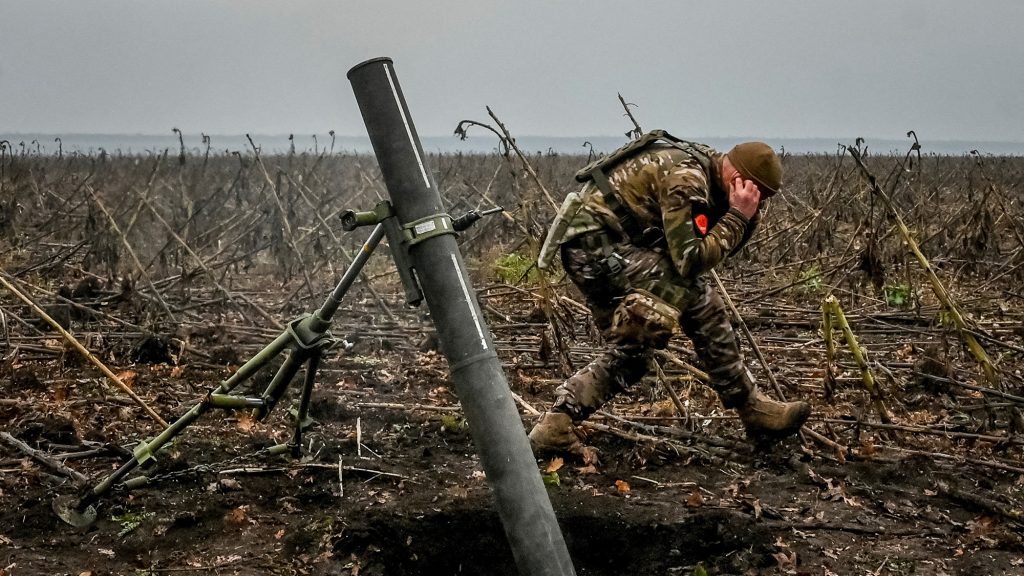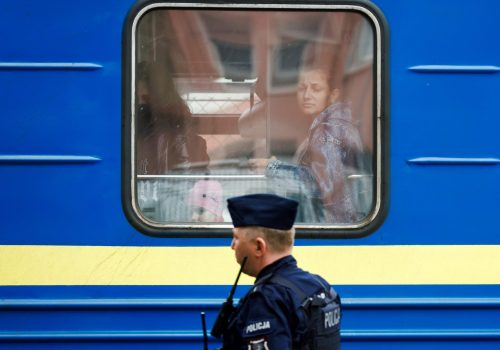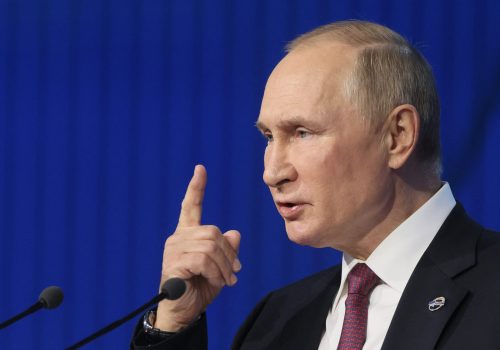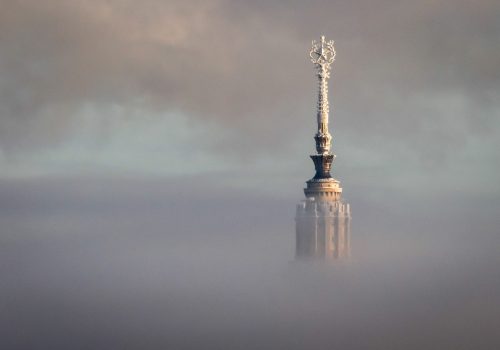In light of the ongoing Russia crisis, the Scowcroft Center’s Forward Defense (FD) practice will share weekly assessments of the latest force developments surrounding Ukraine, leveraging the expert perspectives of our senior military fellows. The opinions, conclusions, and recommendations expressed or implied here are solely those of the authors and do not represent the views of the Department of Defense or any other US government agency.
The bottom line
On November 9, Russian Defense Minister Sergei Shoigu announced the withdrawal of Russian troops from the city of Kherson, a significant and embarrassing defeat for the Kremlin. Kherson, one of the regions annexed through sham referendums, represented the only regional capital that Russia had seized since the war began, and its loss is not only tactically but strategically damaging. However, Russian and Ukrainian forces face a long winter ahead, as changing weather will complicate both offensive and defensive operations in the coming months.
No doubt, Armed Forces of Ukraine (AFU) troops bedding down in Kherson are asking themselves “what are we doing next?” Indications are that this war will continue for some time, despite the AFU’s incredible and valorous successes. Ukraine must carefully balance the allure of capitalizing on momentum against a weakened opponent with the challenge of sustaining hard-won gains through the winter.
However, time is not on Kyiv’s side. Ukraine’s ability to sustain the fight against Russia hinges on NATO and US support and, as the West endures higher energy and food costs, the calls for an end to the war will only grow louder.
The calendar—and conditions—change
Building on momentum. The AFU unquestionably has the momentum in the war given a string of victories in Kharkiv, Izyum, Lyman, and now Kherson—this despite Russia utilizing terror tactics such as targeting Ukrainian power infrastructure and civilians, indiscriminate targeting with Iranian loitering munitions, and threatening the Zaporizhzhia nuclear power plant. The AFU effectively cut off Russian troops from critical ground lines of communication across the Dnipro River through systematic targeting of bridges and crossings. Over time, these tactics eventually forced Russia to concede that its position was impossible to defend and proved decisive in avoiding catastrophic urban warfare.
- Winter is coming. As winter approaches, the type of offensive operations that the AFU has successfully executed will become increasingly challenging due to harsh weather, ground conditions, and shifting prioritization for sustainment and logistics. Ground mobility, concealment, and reconnaissance can all become increasingly difficult in the mud, snow, and brutal cold weather conditions in the region. Accordingly, we are seeing AFU requests for international support shift from tanks to air defenses and now to sustainment equipment such as generators. The inherent challenges of warfare, particularly offensive operations, in cold weather conditions may impact decision-making on the consolidation of gains versus onward advancement.
- The Kremlin’s approach. Russia is moving to consolidate into more defensible positions in historically held terrain to the east of the Dnipro River and to the south near Crimea. Given the challenges Russia has had with training and equipping its newly mobilized troops (numbering around three hundred thousand personnel), consolidation to more advantageous defensive positions may allow for the time necessary to properly outfit new units. In fact, it may be Russia’s tactic to force a stalemate through the winter from more entrenched positions with the intent to begin rotating newly trained and equipped mobilization forces to the front as spring approaches.
Mother nature is the great equalizer. The tactical realities of cold-weather operations will likely impact all parties. Modern militaries recognize “cold weather training” as an indispensable skill set in a conventional fight. Underestimating the effects of winter on operations often results in disaster. Weapons systems malfunction. Engines seize or do not start at all. Combined arms operations are disrupted. Extreme cold hampers gross and fine motor skills, cognition, and the overall performance of the human beings attempting to execute a multitude of warfighting tasks—especially over time.
- Planning ahead. Success or failure in sustaining the fighting is directly linked to a force’s ability to plan, adapt, and anticipate the needs of the warfighter. Mud and fog disrupt ground combat operations by impeding speed and mobility. When a unit’s freedom of movement is compromised, its ability to link up with logistics trains can fail miserably, because those evolutions are often tied into a larger sustainment operation within a particular theater.
- Sustainment delays impact operational tempo. Interruptions can have profound influence over both the execution and the outcome of a plan. Refueling, rearming, and resupplying all become infinitely harder in poor weather conditions because throughput methods, distribution systems, and delivery platforms are vulnerable to temperature, precipitation, and fog. Sustainment operations are conducted via multiple domains, and a disruption or delay due to weather on one platform likely has a domino effect on others, further complicating the time and sequencing in which units receive fuel, ammunition, medical supplies, water, equipment, and casualty replacements. While seemingly a singular tactical action, one surface connector or aircraft failing to execute delivery of sustainment on-time or on-target reverberates across the force, resulting in strategic impacts to operations.
Is the best defense a good offense? The question to the AFU at this juncture is how much farther to press the offensive given the increasing challenges presented by winter, as well as the strains on a force that has been sustaining a high operational tempo. President Volodymyr Zelenskyy has openly stated his intent for Ukraine to regain full control of its territory within its internationally recognized borders, which would include retaking Crimea.
- Assessing tradeoffs. On one hand, the AFU is at its greatest position of advantage since the war began in February. It continues to enjoy high levels of support from the United States and European allies, and the momentum gained through the successful counter-offensive campaign has seemingly increased Ukrainian resolve. These factors may persuade Ukraine to capitalize on its momentum and push the fight beyond Kherson and potentially into Crimea. However, degrading winter conditions historically favor the defensive-minded “home team.” A move to retake Crimea would be an expeditionary offensive operation, which would bring with it a significant sustainment and logistics problem given Crimea’s geography. It would also place high demands on AFU forces to project combat power into a region that has been controlled by Russia since 2014, and such an offensive directly brings in the maritime domain, introducing the potential that the domain could be leveraged in a more meaningful way as war continues.
- Asymmetric options. The AFU could utilize some of its offensive capacity to asymmetrically harass Russian forces in disparate locations across the line of contact, keeping Russian resupply mechanisms engaged without forcing large-scale battles of attrition. Russia may look to rotate more experienced officers off the line to enable better training and equipping of mobilized forces. A campaign of unpredictable and asymmetric attacks by the AFU could be a more agile means to disrupt Russia’s ability to exploit a lull and better posture mobilized forces for future offensive operations.
- Going on the defensive. The most conservative approach would be for Ukraine to fortify positions across the recently gained territory and attempt to rotate units from the line, capitalizing on a potential lull in activity through the winter. However, this approach could allow for the time and space the Kremlin needs to better train and equip its mobilization force, ultimately improving its position for the spring. While offensive operations are more challenging in winter conditions, Russia will most likely continue to conduct rocket and missile attacks on Ukrainian infrastructure in an attempt to break the will of Ukraine and its allies.
Subscribe to our military assessments
Sign up for updates from Forward Defense to hear the latest on the trends, technologies, and military challenges shaping tomorrow.
When should Ukraine sue for peace?
The road to peace. The Ukrainians will have to negotiate with Russia at some point to end the war. Ukraine likely will not be able to achieve everything it wants, so compromising sooner rather than later may be prudent. Zelenskyy will have to calculate the odds that his military campaign will continue to overperform, the probability that foreign aid will continue to flow smoothly into Ukraine, and the chances that Russian President Vladimir Putin blinks first. These calculations are extremely hard for any wartime leader, and Zelenskyy will be no exception.
- Defender’s advantage. Ukraine’s military has outperformed everyone’s expectations to date but re-taking the entirety of the Donbas and Crimea will likely be more challenging because Russia has taken a primarily defensive posture. That posture comes with considerable benefits, including a significant information advantage, simpler sustainment plans/routes, and fixed fortifications. Russia arguably overextended on its flanks in Kharkiv and Kherson. Now that Russia is pulling back and taking a more consolidated, deliberate defensive posture, it will naturally reclaim many tactical advantages, including shorter lines of communication and less complicated resupply plans.
- The limits of international support. There is a fair possibility that the West holds back resources to force Ukraine to the negotiating table, and this probability only increases as war continues. A new and divided US Congress will convene on January 3, and although there is movement to pass a substantial aid package in the coming weeks during the lame-duck session, increased budgetary gridlock in 2023 could result in a slowdown or gap in resourcing. While most in the West publicly support Zelenskyy’s lofty goals for Ukraine, practicality is starting to weigh more heavily into the search for an end to the war. The costs to keep Ukraine solvent and the eventual costs to rebuild the country also matter to the West.
Meet the FD team
The Scowcroft Center Military Fellows Program, housed by the Forward Defense practice, hosts military fellows from participating branches of the US military and the armed forces of US allies and partners each year as part of a twelve-month fellowship program.
Further reading
Thu, Nov 3, 2022
Russia hopes a winter wave of Ukrainian refugees will divide Europe
UkraineAlert By
Russia's campaign of airstrikes against Ukraine's civilian infrastructure aims to spark a humanitarian crisis and fuel a new winter season refugee wave that Moscow hopes will undermine European support for Ukraine.
Sun, Oct 30, 2022
The West must not let Putin freeze millions of Ukrainians to death
UkraineAlert By
Unable to defeat Ukraine on the battlefield, Putin is now deliberately targeting the civilian population and openly threatening to freeze millions of Ukrainians to death. The West must not stand by and let this genocide take place.
Mon, Oct 3, 2022
European unity is essential as Putin prepares to weaponize winter
UkraineAlert By
European unity will be vital in the coming months as Russia attempts to weaponize winter in order to convince EU leaders to abandon their support for Ukraine and end their opposition to Vladimir Putin's ongoing invasion.
Image: A Ukrainian serviceman fires a mortar on a front line, as Russia's attack on Ukraine continues, in Zaporizhzhia region of Ukraine on November 16, 2022. Photo via REUTERS.



